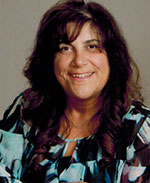Coccidioidal Meningitis (CM)
The most deleterious extrapulmonary dissemination is the spread of Coccidioides spp. to the central nervous system (CNS) causing meningitis. A lumbar puncture with analysis of cerebrospinal fluid (CSF) should be done in any patient with suspected or previously diagnosed coccidioidomycosis presenting with a headache, blurry vision, photophobia, meningismus, decline in cognition, hearing changes, and focal neurologic deficit. As illustrated in a recent retrospective study there is no evidence to support routine CSF analysis in patients in at-risk groups (age, ethnicity, CF titer, etc.) if they do not have CNS symptoms (1). The diagnosis of CM is based on a positive serologic testing (ID/CF) or culture of CSF. CSF analysis typically shows an elevated white blood cell count with a mixed or lymphocytic pleocytosis, a high level of protein (sometimes measurable in g/dL rather than mg/dL), and a low level of glucose. Imaging studies are helpful in evaluating complications associated with meningitis. Initial features of illness may be difficult to distinguish from other etiologies without detailed testing, notably tuberculosis and even autoimmune illnesses.
When left untreated, CM is uniformly fatal (2). In a historical series reported by Vincent et al, before the availability of antifungals, seventeen patients with CM were followed all of whom died within 31 months (2). This review also commented on the combined survival statistics described in five reports of 117 patients where 91% of patients with CM died within one year and all died within 2 years. Though the fatality has improved with the use of AmB and azoles, morbidity is still substantial due to complications from the disease, devices used for treatment management, and side effects of the medications as much higher recommended doses are necessary for prolonged period of time (3).
The most common life-threatening complications of meningitis include hydrocephalus, CNS vasculitis, cerebral ischemia, infarction, vasospasm and hemorrhage. Basilar meningitis and spinal cord involvement may also be encountered. In patients with hydrocephalus, a ventricular shunt is necessary for decompression. Such shunts, often placed distally into the abdominal cavity may develop secondary infections, obstruction due to persistent coccidioidomycosis, and/or abdominal pseudocysts (4). It is not uncommon for patients to require multiple shunt revisions. As illustrated in several case reports, repeated obstruction of the shunt and isolation of fungus should alert one to seek alternate antifungal therapy. Some clinicians have used steroids for vasculitis though this is considered anecdotal.
For treatment of CM, most clinicians prefer therapy with oral fluconazole (5). Although the dose studied in an uncontrolled clinical trial was 400 mg, it is common to begin therapy with 800 to 1200 mg per day of fluconazole (3, 6). Prior to the advent of azoles, amphotericin B deoxycholate (AmB) was the only drug of choice but was ineffective when given intravenously and required frequent administrations via the intrathecal (IT) route. Due to challenges of administration, toxicity associated with this route and lack of experience in utilizing this method, current practitioners seldom resort to recommending AmB as initial therapy although lipid formulations have been used in the salvage setting successfully (7). Though there are no trials comparing IT AmB and fluconazole, the response rate of IT AmB has ranged from 51%-100% in studies published before 1986 and with fluconazole the rate is near 79% (6, 8). With fluconazole symptoms resolve within 4-8 months though there is a delay in normalization of CSF abnormalities which may persist in the presence of a shunt. Based on clinical experience and due to an extremely high relapse of 78% noted in a small series when therapy is discontinued, lifelong treatment with azoles is recommended (9).
Assessing a patient’s response to therapy is primarily a matter of serial evaluation and clinical judgment. Favorable signs include return to premorbid functioning, decreasing CF titers, and excellent adherence to medical care and therapy. Some patients with chronic meningitis have refractory illness with poor recovery or exceptionally slow improvement. A combination of serology and repeated CSF evaluation may be necessary to assess microbiologic and serologic improvement. Adherence counseling, assessment of drug-drug interactions, therapeutic drug monitoring, and consideration of alternative antifungal therapy may be necessary. For CM patients who are failing treatment and/or have refractory coccidioidal disease, salvage regimens may be necessary. Both voriconazole and posaconazole have been used in this situation, with a growing body of case series and clinical experience to support their use.
REFERENCES
- Thompson G, 3rd, Wang S, Bercovitch R, et al. Routine CSF Analysis in Coccidioidomycosis Is Not Required. PloS one 2013; 8(5): e64249.
- Vincent T, Galgiani JN, Huppert M, Salkin D. The natural history of coccidioidal meningitis: VA-Armed Forces cooperative studies, 1955-1958. Clin Infect Dis 1993; 16(2): 247-54.
- Johnson RH, Einstein HE. Coccidioidal meningitis. Clinical infectious diseases : an official publication of the Infectious Diseases Society of America 2006; 42(1): 103-7.
- Hibbett DS, Binder M, Bischoff JF, et al. A higher-level phylogenetic classification of the Fungi. Mycol Res 2007; 111(Pt 5): 509-47.
- Galgiani JN, Ampel NM, Blair JE, et al. Coccidioidomycosis. Clinical infectious diseases : an official publication of the Infectious Diseases Society of America 2005; 41(9): 1217-23.
- Galgiani JN, Catanzaro A, Cloud GA, et al. Fluconazole therapy for coccidioidal meningitis. The NIAID-Mycoses Study Group. Annals of internal medicine 1993; 119(1): 28-35.
- Mathisen G, Shelub A, Truong J, Wigen C. Coccidioidal meningitis: clinical presentation and management in the fluconazole era. Medicine 2010; 89(5): 251-84.
- Bouza E, Dreyer JS, Hewitt WL, Meyer RD. Coccidioidal meningitis. An analysis of thirty-one cases and review of the literature. Medicine 1981; 60(3): 139-72.
- Dewsnup DH, Galgiani JN, Graybill JR, et al. Is it ever safe to stop azole therapy for Coccidioides immitis meningitis? Annals of internal medicine 1996; 124(3): 305-10.


 Karryn Doyle, CCEP
Karryn Doyle, CCEP